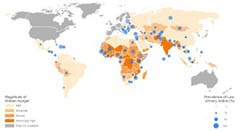The following post by Sight and Life Director Klaus Kraemer was originally published on the Global Nutrition Report website.
As we approach World Food Day, we must not overlook a hunger that does not always respond to just the provision of food — hidden hunger.
Recognizing the critical importance of the issue, the annual Global Hunger Index (GHI), produced by the International Food Policy Research Institute (IFPRI), Concern Worldwide and Welthungerhilfe highlights hidden hunger in this year’s report.
Hidden hunger is not malnutrition as classically presented as the hungry or starving individual, but malnutrition as it should properly be defined: poor overall quality of nutrition. It is the chronic lack of essential vitamins and minerals. As the name suggests, the signs are not always visible but it leaves a devastating and often lifelong legacy for ill-health, reduced productivity and restricted mental development.
Micronutrient deficiencies are an urgent public health problem that affects over two billion people worldwide and seriously hinders economic growth. In developing countries, multiple micronutrient deficiencies often occur concurrently in the same population, accounting for approximately seven percent of the global disease burden annually and costing $180 billion each year.
To address this largely invisible threat, we need to know where it lurks. In 2013, Sight and Life, in collaboration with leading scientists, academics and decision-makers from a range of global institutions, published the first global Hidden Hunger Index and map. While previous maps had depicted single micronutrient deficiencies, the Index documented, for the first time, the combined burden in preschool children of multiple micronutrient deficiencies: vitamin A, zinc, iron and iodine.
The results were sobering. The analysis found that there were global hot spots of hidden hunger, with the prevalence alarmingly high in sub-Saharan African countries as well as India and Afghanistan, and severe in many countries in South-Central/South-East Asia. In most of the 20 countries with the highest Hidden Hunger Index scores, 40 percent of preschool children were estimated to be stunted, more than 30 percent were anemic due to iron deficiency and more than half were vitamin A deficient. Thus condemning these children to a life of diminished potential.
More concerning was that the Index also found that a high Hidden Hunger Index score strongly correlated with a low Human Development Index score—a composite measure of three basic dimensions of human development: a long and healthy life, level of education and a decent standard of living.
This means that addressing hidden hunger—whether through greater dietary diversity, targeted supplementation, biofortification of staple crops or fortification of staple foods—will help accelerate development and give children a chance to develop to their full physical and mental potential.
We know micronutrient interventions work. Research has shown that vitamin A supplementation reduces under-5 child deaths by approximately 25 percent. Universal salt iodisation—now common practice in 70 percent of developing-country households, up from 20 percent in 1990, has resulted in major progress combating iodine deficiency, the world’s leading cause of mental impairment and brain damage. Folic acid fortification of flour is now required in 80 countries, reducing cases of brain and spine birth defects by up to 70 percent.
Not surprisingly, the landmark 2013 Lancet Series on Maternal and Child Nutrition called for maternal multiple micronutrient and calcium supplementation as key interventions that can save 102,000 lives per year as part of a package of interventions during pregnancy, which also includes universal salt iodisation. Another 145,000 lives could be saved through vitamin A and zinc supplementation for children, according to the Series.
These interventions are also highly cost-effective. The 2012 Copenhagen Consensus panel of experts ranked providing micronutrients to preschoolers as the single smartest way to allocate global aid dollars, with every $1 spent generating $30 in social benefits.
But where can nutrition interventions have the most impact? In which countries, regions and communities? Which interventions are most effective?
Governments and donors need data to make informed policy and program decisions. Resources such as the forthcoming Global Nutrition Report and GHI aim to provide this much-needed evidence. And later this year, Sight and Life will publish an update to the Hidden Hunger Index, that will for the first time show trends in multiple micronutrient deficiency from 1995-2011.
Countries, donors and development partners working to scale up nutrition should embrace these resources when deciding where to focus national strategies and programs. These resources offer an opportunity to develop a unified approach—using a variety of culturally appropriate interventions, from behavior change communication to fortification and supplementation—for alleviating hunger and hidden hunger.
Because decisions made in conference rooms ripple through schoolhouses and villages.
This could mean a mother will, as part of her child’s ongoing clinic visits, receive essential micronutrient powders to sprinkle on her preschooler’s breakfast porridge, so he can learn and thrive in school.
This could mean a toddler will twice-yearly get her vitamin A capsule to help prevent diseases that may otherwise be fatal, and save her eyesight.
This could mean prenatal multiple micronutrient supplements will arrive in a village, be given to pregnant women and so help ensure that the next generation of children have a better start in life.
So share these resources. Use them. And make smart investments in and for your country.
Klaus Kraemer is the director of Sight and Life, a nutrition think tank that works toward a world free of malnutrition, and Adjunct Associate Professor in the Department of International Health of Johns Hopkins Bloomberg School of Public Health. Sight and Life champions the global fight against malnutrition by advancing research, sharing best practices and mobilising support to improve the lives of the world’s most vulnerable. Sight and Life and DSM are currently leading Vitamins in Motion, an initiative to advance worldwide health and economic development through increased access to the essential vitamins all people need to be healthy and well-nourished. Follow Sight and Life on Twitter at @SightandLife for news on the forthcoming Hidden Hunger Index update.







